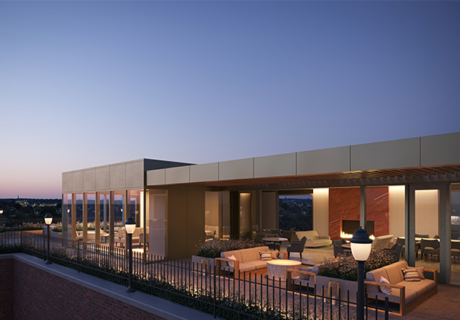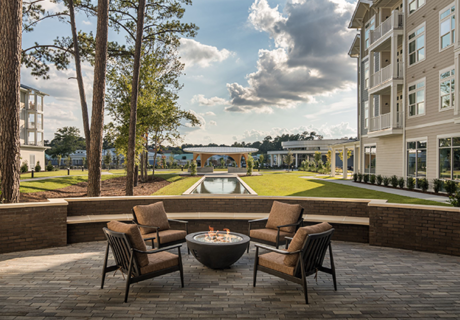The Stories: All Ages Welcome
When Ryan Frederick, founder and CEO of Smart Living 360, a Baltimore-based residential development company, set out to build a new senior housing community in Maryland, he didn’t start with a target resident population in mind. Rather, he had a target mindset: independent seniors who are focused on achieving personal well-being; having a purpose; and being socially connected, active, and engaged in the broader community. “We’re approaching a time where [senior living] is ready for significant changes,” he says.
Part of what’s driving this evolution is the reality that many seniors are postponing moves to independent living until later in life, Frederick says, adding that the average age of residents is around 84 nationally. Additionally, aging baby boomers have different expectations for their environments than past generations. “They tend to want to be around where the action is and around people of all ages, and they want to be in control,” he says.
Frederick says while the market has begun to shift from remote, secluded senior housing communities to more urban projects, there’s still an age restriction. “We found that people don’t want to be segregated by age,” he says. So, Frederick set out to create a place that brings together people of all ages who are seeking a lifestyle focused on health and community connections.
After meeting Donald Wood, president and CEO of Federal Realty Investment Trust (Rockville, Md.), a real estate development company, the two decided to co-develop a new multigenerational housing project; The Stories at Congressional Plaza, located in a 380,000-square-foot shopping center in Rockville, Md., opened in spring 2016 with 48 apartments for rent.
Frederick says the community is designed to work for people of all ages, using universal design features and providing access to community services, such as life coaches or pet-sitters, on an as-needed basis. A year after opening, Frederick says the community is full with residents who cross multiple generations, including millennials, GenXers, baby boomers, and the Greatest Generation.
Creating a community
Bringing together people of all ages wasn’t the only goal with The Stories, Frederick says. “The plan is to have people more connected,” he says. “So we needed spaces where it’s natural to congregate.” One of the first things you see when you walk in is a large living room area with a fireplace, residential-style furnishings including couches and oversized seating, and “things that really draw you in and make you feel comfortable,” says Gordon Godat, principal at JP2 Architects, the interior design firm on the project. Orange ottomans and a multicolored stone fireplace add punches of color and tie in with the modern aesthetic. There’s no TV here on purpose, Frederick adds.
Off this main gathering space is a full kitchen, with appliances, tabletop and island seating options, and a community coffee/tea station that’s available for hosting events, community dinners, or parties. The living room opens out onto an outdoor patio that’s purposely located on the front side of the building rather than on the rooftop or secluded out back. “We’re trying to optimize spontaneous interactions,” Frederick says. “It makes it feel more like a community rather than a building.”
To appeal to a broad age range, Godat says the community has a high-end and modern aesthetic with some warmer tactile elements, like wood floors and residential style furnishings, to make it feel homey. “Today’s retiring generation expects a higher level of design,” he says. To appeal to residents’ desire for health and well-being, the first floor also houses a fitness room and flexible conference room, where meetings, wellness classes, and other activities can be hosted.
Upstairs, it was important that the apartments didn’t look like they were designed for a specific age, Frederick says: “It’s just good design.” The community offers one-, two-, and three-bedroom apartment layouts all featuring universal design elements such as bright task lighting, slip-resistant tile, roll-out shelving, ergonomic handle levers and hardware, and higher-placed electrical outlets. Backing for grab bars or TV mounts is built into the walls so that those elements can be easily added as residents’ needs change.
The modern upscale aesthetic established on the first floor extends into the units with granite countertops, stainless steel appliances and fixtures, dark wood cabinetry, and mosaic tile backsplashes in the kitchens. The bathrooms feature a similar materials palette and include a step-in shower with a seat. Tech-savvy residents can also choose to customize their apartment with optional upgrades, including smart thermostats and digital home entertainment products.
À la carte services
Frederick wanted The Stories to help residents access services as they become necessary, so it added a concierge desk at the front door where a staff person is available to assist residents in connecting with vetted providers, such as pet sitters, or help facilitate activities such as volunteer opportunities, speaker visits, or book clubs.
The community also has established relationships with lifestyle and health providers, including life coaches, wealth advisors, and personal fitness instructors, which residents can access when they have a need. As telehealth grows in popularity, Frederick says he envisions a first-floor conference room as a flex space to support visits from nurse practitioners or conference calls with doctors, so there’s broadband in the building and Wi-Fi in every apartment.
To strengthen access to the community at large, the project also established a pedestrian connection between The Stories and neighboring The Crest at Congressional Plaza, a boutique apartment building, with upgraded exterior lighting, curb cuts, and a dedicated pathway, helping residents access additional amenities, including a theater and swimming pool at The Crest.
Overall, Frederick says the hardest part of the project wasn’t getting the design details right; it’s been getting the word out about the vision and being able to attract a range of ages. As such, The Stories has intentionally done a few things differently, he says, such as offering longer leases (up to three years) so residents can plan for predictable costs and allowing personalization of some of the interior fit-out of their apartments, such as the color of the accent wall in the living room and the carpet, to help make it feel like their own space.
Frederick says most residents are “renters by choice,” or people who could afford a home but are choosing the lifestyle offered at The Stories instead. “This is more than just a building,” he says. “One’s living environment … should be more than simply a place to hang your hat. An inspired living environment that makes it easy to meet people; hear engaging speakers; links people to valued services, walkable and otherwise; etc., is simply better.”
Anne DiNardo is executive editor of Environments for Aging. She can be reached at ANNE.DINARDO@EMERALDEXPO.COM.











